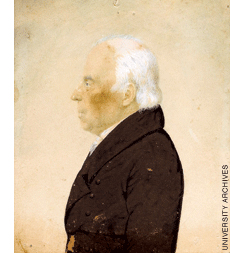
In 1801, during his first year in the White House, Thomas Jefferson received a letter from a Penn mathematics professor named Robert Patterson. Patterson was a frequent correspondent of the president, but this particular missive was not exactly filled with cursive chitchat. It aimed instead to be “absolutely inscrutable.” It culminated in a block of letters crammed together without spaces or punctuation, arranged in what Patterson considered an unbreakable secret code.
Jefferson was no stranger to ciphers, having designed one of his own that employed an iron spindle and a series of wheels inscribed with the letters of the alphabet in scrambled order. Patterson considered his code more elegant. It involved neither mechanical gadgetry nor laborious memorization. It was simple to read and write—provided, of course, one knew the trick.
So confident was Patterson that he included an example to show his commander-in-chief exactly how it worked. The cipher, he showed, was oriented vertically rather than horizontally. Solving it was a matter of figuring out how many discrete sections were contained in his block of text, the order in which the lines therein had been transposed, and the number of random letters that had been added to the beginning of each line. He demonstrated that the key consisted of several double-digit numbers referring to the manipulation of certain lines and letters.
Then he challenged Jefferson to solve the “specimen of such writing” with which he ended his letter, this time withholding the key.
“I presume the utter impossibility of deciphering will be readily acknowledged,” Patterson declared. “I may safely defy the united ingenuity of the whole human race,” he added, “to the end of time.”
His boast would stand the test of 205 years. In 2007, Lawren Smithline, a professional code-breaker at the Center for Communications Research in Princeton, N.J., cracked the cipher “using a method that has become common in computational biology.” He described his approach in the March|April issue of American Scientist magazine.
As Smithline discovered, the Penn professor may have given the president a bigger challenge than he could handle, but he played more than fair. The text Patterson encoded in his letter would have been instantly recognizable to Jefferson as being partially his own: the Declaration of Independence.
—T.P.

